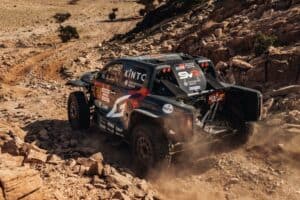Avid Formula 1 (F1) fans will be aware of specific terminology used by television commentators and pundits: DRS. Here's what you need to know.

Comments regarding drag and downforce are common during the F1 season.
In March, many South Africans turned to Google with one question: What is DRS in Formula 1?
Most will know DRS is an acronym for Drag Reduction System, but some readers have asked what exactly it is. I shall attempt to explain.
DRS in F1 – What you need to know
Drag Reduction System (DRS) explained
Since the introduction of DRS in 2011, you will have regularly heard of ‘DRS zones’, that ‘DRS is enabled’, a car is within ‘DRS range’, and that a car’s ‘DRS is now open’.
A Formula 1 car basically needs speed and good road holding to be successful.
Over the years, improved engines and transmissions have provided amazingly high power outputs and incredibly fast gear changes.
However, without the ability to grip the road improvements to both engine and gearbox would be pointless.
To increase the grip an aspect of the aviation industry was employed and the science of aerodynamics entered the world of F1.
Using air to increase pressure and downforce
The cars benefitted from the application of this new technology and initially, it meant more streamlined shapes for higher speeds.
Then the idea of using inverted wings to improve the cars’ grip on the track appeared, initially as front and rear wings supported on flimsy uprights and later extending to the entire body shell as an integral part of the design.
The rear wing uses the air flowing over it to increase the pressure and create a large amount of downforce which increases the grip allowing high-speed cornering.
Unfortunately, it also adversely affects performance as increased downforce means friction, referred to as drag, which reduces straight-line speed.

Advantages of DRS in F1
The advantages created by the aerodynamic applications were obvious but unfortunately, it also created an unseen problem.
Due to the airflow over and around the car, the air behind is extremely turbulent; this is referred to as “dirty air”, and it radically affects the aerodynamics of a following car.
This disturbance prevents a car from closing right up to the rear of the car ahead to slipstream or get a tow in its wake, which previously allowed an overtaking opportunity. Something needed to be done and it was.
ALSO READ: Hamilton reiterates F1 must return to South Africa
Recent changes to DRS in F1
The rear wing was divided horizontally, the main plane being thicker and fixed, while the upper section or flap was smaller and hinged.
This allows it to be raised to a maximum of 85 mm which lets the air pass through freely and the speed to increase.
Obviously, this decreases the downforce on the rear but on the straights of any circuit the car needs less drag, not high downforce. Raising the flap increases speeds by around 12k m/h and gives drivers the ability to pass.
DRS activation and rules
The Drag Reduction System is activated by the driver via a button on the steering wheel.
It may only be activated in the specified DRS zones of the track, and only when the chasing car is within one second of the car ahead. Braking deactivates the system on the car.
DRS is not available within the first two laps of the race start or a restart after a safety car period. And so ends our sermon on DRS in F1.






